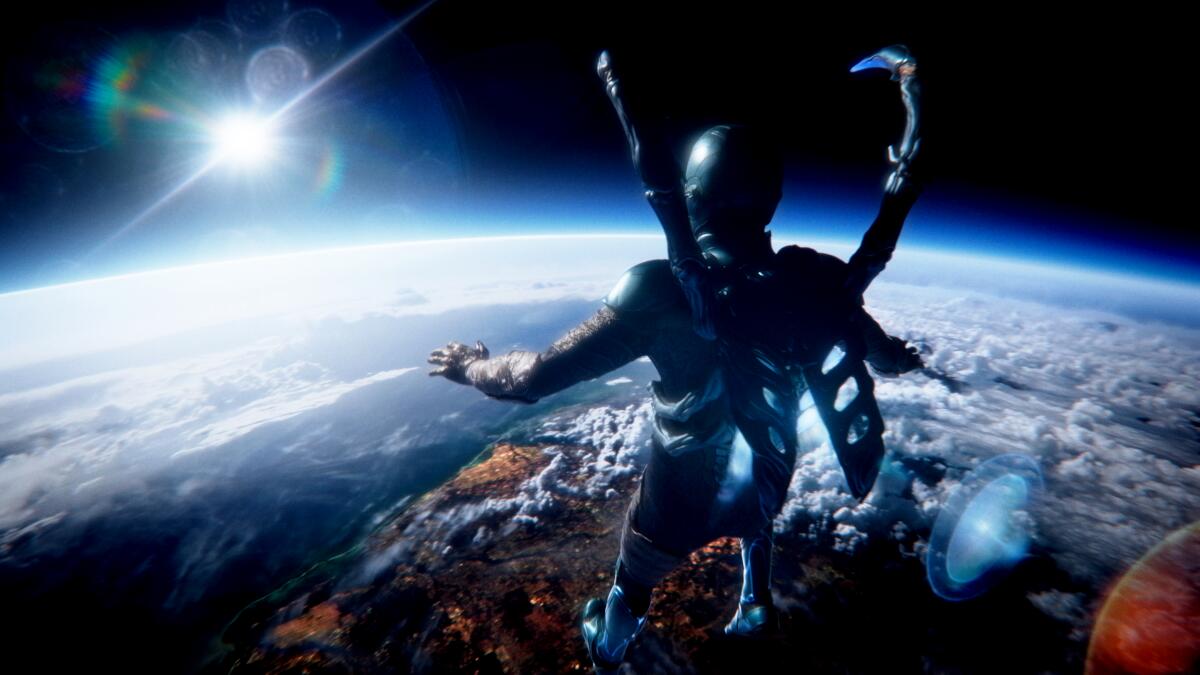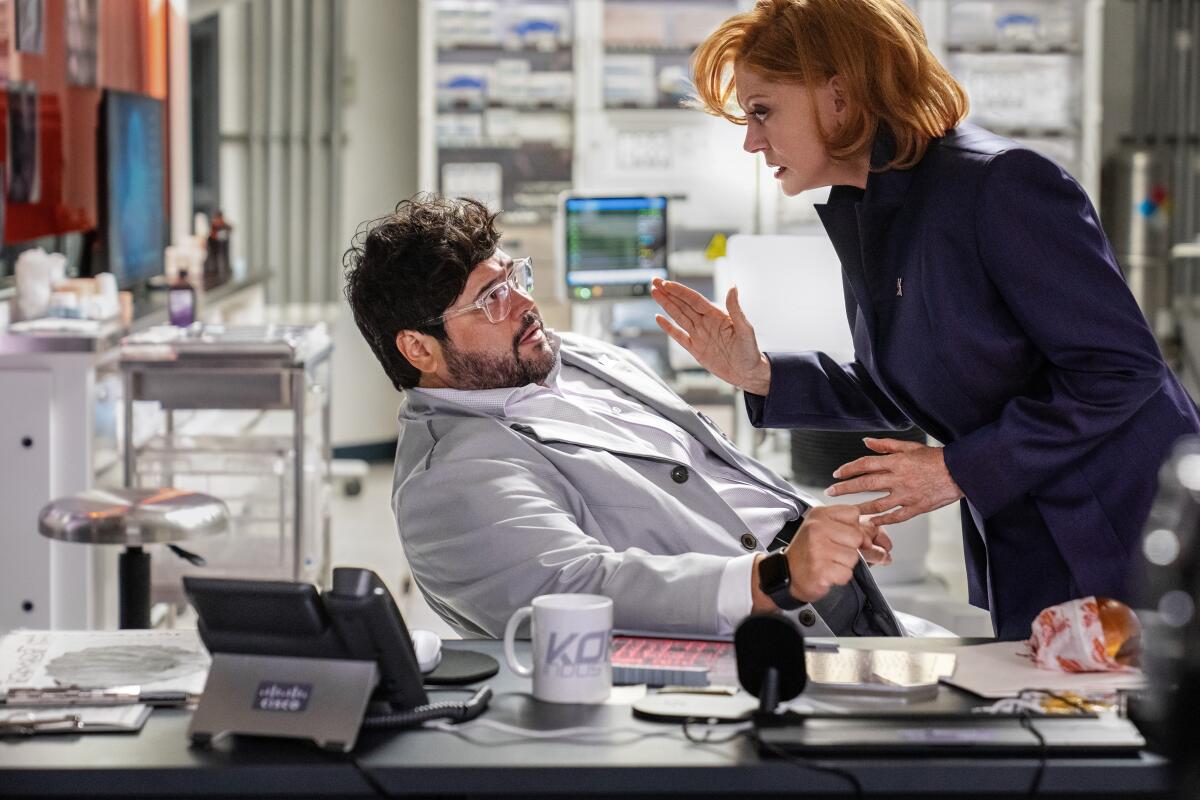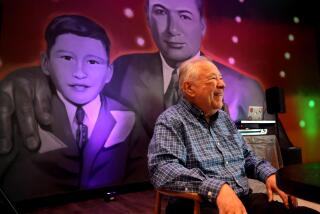Review: Refreshingly, ‘Blue Beetle’ injects DC universe with Latino richness and focus

For Jaime Reyes — the Blue Beetle — being a superhero is a family affair. While most superheroes shield their identities from loved ones, in “Blue Beetle,” the first DC Comics movie to feature a Latino superhero, it’s a group project.
When recent college grad Jaime (Xolo Maridueña) unknowingly brings home an alien scarab in a fast-food box handed to him by industrial heiress Jenny Kord (Bruna Marquezine), which she spirited away from the headquarters of the family business, he’s egged on by his sister Milagro (Belissa Escobedo) and Uncle Rudy (George Lopez) to check it out. The scarab quickly responds to him, his entire family watching in horror as the critter fuses onto his spine, forming a symbiotic relationship that affords Jaime the powers of a sentient battle suit complete with a Siri-style intelligence, Khaji-Da (voiced by Becky G).
The alien suit may be nifty, allowing him to fly and fight and conjure weapons out of thin air, but Jaime derives his strength and drive from the tight-knit Reyes clan. His family is a crucial component in the comic books, lovingly transferred to the screen by director Angel Manuel Soto and writer Gareth Dunnet-Alcocer. The first Latino superhero movie is a true reflection of Latino culture, including the food, the music, the history and the focus on family, first and foremost.
It’s a lot to juggle, and sometimes Jaime gets a little lost in the shuffle of “Blue Beetle,” swallowed up by the cerulean suit, or upstaged by Uncle Rudy, a paranoid techie with a long mullet, sassy sister Milagro and his abuela Nana (the legendary Adriana Barraza), who has a secret history of her own. But Maridueña is so charming as Jaime that we’re left wanting more of the title character, which is ultimately a good thing for this new phase of the DC Extended Universe.
“Blue Beetle” is a good old-fashioned origin story, a stand-alone film unrestrained by crossovers and cameos. As a hard reset for the troubled DCEU, it’s refreshing, despite its adherence to formula. Soto and Dunnet-Alcocer inject the film with a welcome dose of tropical Latin flavor, a new set of values and a fair amount of humor; at times it can be a bit goofy, but that proves to be a powerful antidote to the otherwise dour tone that has bogged down DC movies of late.

As Jaime, Maridueña expresses the wide-eyed innocence and wonder of a Peter Parker type, which is apt, considering that the Blue Beetle is essentially the Spider-Man of DC (young kid gets bitten by a super-powered bug, high-flying high jinks ensue). In “Blue Beetle” that origin story is accompanied by a dystopian satire straight out of a Paul Verhoeven movie.
In the futuristic Palmera City (if Gotham is the New York City of DC Comics, Palmera City is the Miami), the Reyes family lives in a humble abode in the Edge Keys, slowly being pushed out by the private corporation Kord Industries, led by the rapacious real estate development mogul Victoria Kord. Susan Sarandon plays Victoria like she’s in “Starship Troopers,” seeking the power of the scarab to develop “RoboCop”-style suits for the militarized police force she’s dubbed “OMAC” (One Man Army Corps). When Jaime and the beetle bond, she sets her sights on him — and his family — instead.
Threaded throughout is a subtly radical storyline about the complex history of Latin America, and the complicated relationship with the United States, including immigration, gentrification and the exploitation of Latino labor and bodies. In the backstories of Nana and baddie Carapax (Raoul Max Trujillo), Victoria’s super-soldier slave, the film also references the legacy of Latin American revolutionaries, and the outsize influence of the U.S. government and industry in political conflicts in Central America in the 1980s. The climactic battle takes place at an ancient, crumbling fort located on an island off of Cuba, referencing the long — yet ongoing — history of colonialism in the Caribbean, a topic that would likely be close to the heart of Puerto Rican director Soto (parts of the film were shot on the island, a U.S. territory).
Ari Aster’s regular cinematographer Pawel Pogorzelski brings a dizzying fluidity to the action sequences, and some interesting moments of handheld chaos to the family dynamic, though the rest of the film is strangely flat and lacks some visual dynamism. Bobby Krlic, known as the Haxan Cloak, sets the movie to an ‘80s-style synth score, blended with needle drops of Latin music, from salsa to Cypress Hill.
It all makes for an appealing blend of flavors and influences, and despite its minor flaws, “Blue Beetle” combines family, history and culture with an upbeat tone to introduce a character who offers an exciting new direction for DC.
Katie Walsh is a Tribune News Service film critic.
'Blue Beetle'
Rating: PG-13, for sequences of action and violence, language, and some suggestive references
Running time: 2 hours, 7 minutes
Playing: In general release
Watch L.A. Times Today at 7 p.m. on Spectrum News 1 on Channel 1 or live stream on the Spectrum News App. Palos Verdes Peninsula and Orange County viewers can watch on Cox Systems on channel 99.
More to Read
Only good movies
Get the Indie Focus newsletter, Mark Olsen's weekly guide to the world of cinema.
You may occasionally receive promotional content from the Los Angeles Times.











